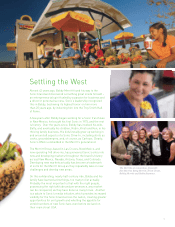Sonic 2014 Annual Report Download - page 20
Download and view the complete annual report
Please find page 20 of the 2014 Sonic annual report below. You can navigate through the pages in the report by either clicking on the pages listed below, or by using the keyword search tool below to find specific information within the annual report.
Management’s Discussion and Analysis of Financial Condition
and Results of Operations
Same-store sales for Franchise Drive-Ins increased 3.5% for fiscal year 2014 and 2.3% for fiscal year 2013, showing continued
momentum from the initiatives we have implemented to improve product quality, service and value perception. Furthermore,
we continued to focus on our innovative product pipeline and increased media effectiveness. Franchising revenues increased
$7.2 million, or 5.3%, for fiscal year 2014 as compared to fiscal year 2013. The increase in franchising revenues was driven by an
increase in franchise royalties primarily attributable to a 3.5% increase in same-store sales and an increase in franchise fees from
the increase in Franchise Drive-In openings. Lease revenues decreased compared to the prior year due to a franchisee’s purchase
during the second quarter of fiscal year 2013 of land and buildings leased or subleased from the Company. The effective royalty
rate increased slightly compared to fiscal year 2013 primarily as a result of improved same-store sales.
Franchising revenues increased by $0.9 million, or 0.7%, to $135.5 million for fiscal year 2013 as compared to $134.6 million
for fiscal year 2012. The increase in franchise revenues was primarily driven by a $4.0 million increase in royalties resulting from
same-store sales increases partially offset by various development incentives and certain franchisee restructuring efforts. These
royalty increases were also partially offset by a $1.8 million decline in lease revenue due to the franchisee’s purchase during
the second quarter of fiscal year 2013 of land and buildings leased or subleased from the Company and a $1.3 million decline in
franchise fees.
Other revenues decreased $0.5 million to $4.3 in fiscal year 2014 and were flat in fiscal year 2013 as compared to the prior
year. The decrease in fiscal year 2014 was partially due to changes in income from minority investments in franchise operations.
Operating Expenses. The following table presents the overall costs of drive-in operations as a percentage of Company Drive-In
sales. Other operating expenses include direct operating costs such as marketing, telephone and utilities, repair and maintenance,
rent, property tax and other controllable expenses.
Percentage
Company Drive-In Margins Points
Year Ended August 31, Increase
2014 2013 (Decrease)
Costs and expenses:
Company Drive-Ins:
Food and packaging 28.7 % 28.5 % 0.2
Payroll and other employee benefits 34.5 35.4 (0.9)
Other operating expenses 21.2 21.4 (0.2)
Cost of Company Drive-In sales 84.4 % 85.3 % (0.9)
Percentage
Company Drive-In Margins Points
Year Ended August 31, Increase
2013 2012 (Decrease)
Costs and expenses:
Company Drive-Ins:
Food and packaging 28.5 % 28.1 % 0.4
Payroll and other employee benefits 35.4 35.7 (0.3)
Other operating expenses 21.4 22.1 (0.7)
Cost of Company Drive-In sales 85.3 % 85.9 % (0.6)
Drive-in level margins improved by 90 basis points during fiscal year 2014 reflecting leverage from improved same-store sales
and, to a lesser extent, the closure of 12 lower-performing Company Drive-Ins on August 31, 2013. Food and packaging costs were
slightly unfavorable by 20 basis points, which primarily resulted from increased costs in beef and dairy that were partially offset
by menu price increases in the second half of the fiscal year. Payroll and other employee benefits, as well as other operating
expenses, improved 110 basis points mainly as a result of leveraging improved sales and the closure of lower-performing Company
Drive-Ins discussed above.
Drive-in level margins improved by 60 basis points during fiscal year 2013 reflecting leverage from improved same-store sales
and, to a lesser extent, the refranchising of 34 lower-performing Company Drive-Ins during the second quarter of fiscal year 2012.
Food and packaging costs were unfavorable by 40 basis points, which primarily resulted from a product mix shift due to summer
promotion activity. Payroll and other employee benefits, as well as other operating expenses, improved 100 basis points primarily
as a result of leveraging labor with improved sales and the refranchising of the 34 drive-ins discussed above.
18
























